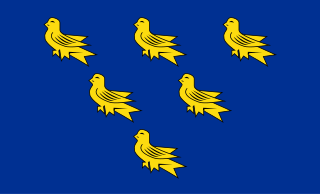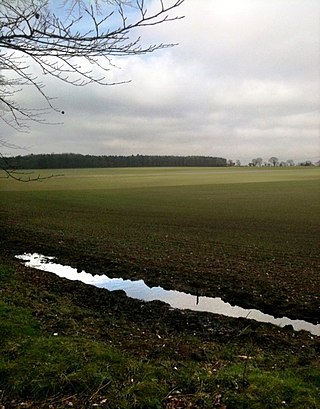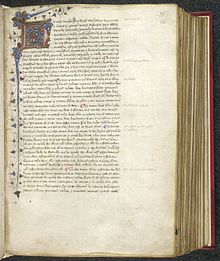
Sussex is a historic county in South East England that is bounded to the west by Hampshire, north by Surrey, northeast by Kent, south by the English Channel, and is divided for many purposes into the ceremonial counties of West Sussex and East Sussex.

The Peasants' Revolt, also named Wat Tyler's Rebellion or the Great Rising, was a major uprising across large parts of England in 1381. The revolt had various causes, including the socio-economic and political tensions generated by the Black Death in the 1340s, the high taxes resulting from the conflict with France during the Hundred Years' War, and instability within the local leadership of London.

WatTyler was a leader of the 1381 Peasants' Revolt in England. He led a group of rebels from Canterbury to London to oppose the institution of a poll tax and to demand economic and social reforms. While the brief rebellion enjoyed early success, Tyler was killed by officers loyal to King Richard II during negotiations at Smithfield, London.
Jack Straw was one of the three leaders of the Peasants' Revolt of 1381, a major event in the history of England.

Humphrey Stafford, 1st Duke of Buckingham, 6th Earl of Stafford, 7th Baron Stafford, of Stafford Castle in Staffordshire, was an English nobleman and a military commander in the Hundred Years' War and the Wars of the Roses. Through his mother he had royal descent from King Edward III, his great-grandfather, and from his father, he inherited, at an early age, the earldom of Stafford. By his marriage to a daughter of Ralph, Earl of Westmorland, Humphrey was related to the powerful Neville family and to many of the leading aristocratic houses of the time. He joined the English campaign in France with King Henry V in 1420 and following Henry V's death two years later he became a councillor for the new king, the nine-month-old Henry VI. Stafford acted as a peacemaker during the partisan, factional politics of the 1430s, when Humphrey, Duke of Gloucester, vied with Cardinal Beaufort for political supremacy. Stafford also took part in the eventual arrest of Gloucester in 1447.

Jack Cade's Rebellion was a popular revolt in 1450 against the government of England, which took place in the south-east of the country between the months of April and July. It stemmed from local grievances regarding the corruption, maladministration and abuse of power of the king's closest advisors and local officials, as well as recent military losses in France during the Hundred Years' War. Leading an army of men from south-eastern England, the rebellion's leader Jack Cade marched on London in order to force the government to reform the administration and remove from power the "traitors" deemed responsible for bad governance. Apart from the Cornish rebellion of 1497, it was the largest popular uprising to take place in England during the 15th century.

Michael Joseph, better known as Michael An Gof, was one of the leaders of the Cornish rebellion of 1497, along with Thomas Flamank.

James Fiennes, 1st Baron Saye and Sele was an English soldier and politician. He was born at Herstmonceux, Sussex, the second son of Sir William Fiennes and his wife Elizabeth Batisford.

Popular revolts in late medieval Europe were uprisings and rebellions by peasants in the countryside, or the burgess in towns, against nobles, abbots and kings during the upheavals between 1300 and 1500, part of a larger "Crisis of the Late Middle Ages". Although sometimes known as Peasant Revolts, the phenomenon of popular uprisings was of broad scope and not just restricted to peasants. In Central Europe and the Balkan region, these rebellions expressed, and helped cause, a political and social disunity paving the way for the expansion of the Ottoman Empire.
Events from the 1450s in England.
Sir John Woodville was the third son and seventh child of Richard Woodville, 1st Earl Rivers, and Jacquetta of Luxembourg.

The history of England during the Late Middle Ages covers from the thirteenth century, the end of the Angevins, and the accession of Henry III – considered by many to mark the start of the Plantagenet dynasty – until the accession to the throne of the Tudor dynasty in 1485, which is often taken as the most convenient marker for the end of the Middle Ages and the start of the English Renaissance and early modern Britain.

Sir Humphrey Stafford, 1st Earl of Devon, 1st Baron Stafford of Southwick was a dominant magnate in South West England in the mid-15th century, and a participant in the Wars of the Roses. A distant relative of the Earls of Stafford, Humphrey Stafford became the greatest landowner in the county of Dorset through fortunes of inheritance. Later, Stafford was one of several men promoted rapidly through the nobility by King Edward IV, to fill the power vacuum left by dead or forfeit Lancastrians. In the West Country it was particularly the forfeitures of the Lancastrian Courtenay family that benefited Stafford. In 1469 he received the Courtenay title of Earl of Devon.
Thomas Cheyny, also known as Bluebeard the Hermit, was a fuller in Kent who posed as a hermit while inciting unrest. He was a leader in Canterbury of the uprising generally known as Jack Cade's Rebellion for which on 9 February 1450 he was captured and shortly afterward hung and quartered.

The Battle of North Walsham was a medieval battle fought on 25 or 26 June 1381, near the town of North Walsham in the English county of Norfolk, in which a large group of rebellious local peasants was confronted by the heavily armed forces of Henry le Despenser, Bishop of Norwich. The battle is significant for being the last occurrence of any major resistance during the English Peasants' Revolt.
Buckingham's rebellion was a failed but significant uprising, or collection of uprisings, of October 1483 in England and parts of Wales against Richard III of England.
The Great Slump was an economic depression that occurred in England from the 1430s to the 1480s.
Sir Robert Poynings, was the second son of Robert Poynings, 4th Baron Poynings (1382–1446). He joined the rebellion of Jack Cade in 1450, and was slain fighting on the Yorkist side at the Second Battle of St Albans in 1461.
Gregory's Chronicle, the Chronicle of London, or MS Edgerton 1995, is the name given to a fifteenth-century English chronicle. It takes its name from its supposed author, William Gregory, who started as a skinner in London and went on to become a London Alderman, Sheriff from 1436 to 1437, and eventually Mayor from 1450 to 1451. The name 'Gregory' for the manuscript is, however, merely a convenience, as its actual authorship is unknown. Indeed, since the chronicle spans the period 1189 to 1470, and William Gregory died in 1467, it is impossible for him to have composed it in its entirety. Other fifteenth-century authors have been proposed, ranging from a contemporary poet to an Ecclesiast, but since even the exact dates of its composition are also debated it has been impossible for historians to definitively attribute the authorship to any known individual.

John Stone's Chronicle is a Latin chronicle covering the years 1415–1471/2. It is preserved in a single manuscript, MS 417, in the library of Corpus Christi College, Cambridge.













